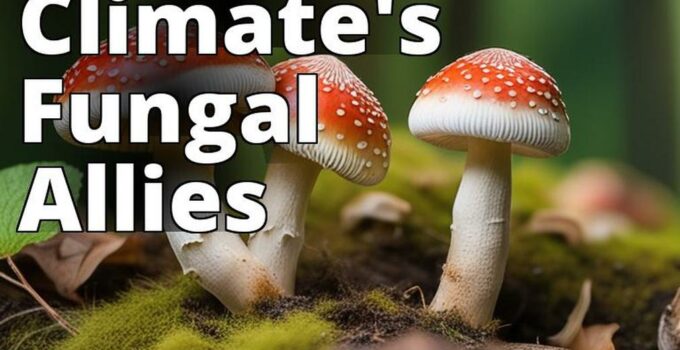The impact of climate change on natural ecosystems and its inhabitants is becoming more evident as the planet warms and weather patterns become more erratic. This includes the Amanita mushroom, a fungus found in many parts of the world. In this article, we will explore the characteristics of Amanita mushrooms, their role in the ecosystem, and how climate change is affecting them. We will also discuss steps that can be taken to mitigate the impact of climate change on Amanita mushrooms and the ecosystem.
Understanding Amanita Mushrooms
Amanita mushrooms are a group of fungi known for their distinctive cap and stem. These mushrooms are found in many parts of the world, including North America, Europe, and Asia. Amanita mushrooms can grow to be quite large, with some species reaching up to 30cm in diameter.
There are many different species of Amanita mushrooms, some of which are edible, and others which are poisonous. The edible species are prized for their flavor and are commonly used in cooking. However, it is important to note that some Amanita mushrooms are highly toxic and can cause serious illness or death if ingested. It is essential to be able to distinguish between different species of Amanita mushrooms to avoid accidental poisoning.
Amanita mushrooms are typically found in woodland habitats, growing in association with trees. They form a symbiotic relationship with the roots of trees, providing them with nutrients in exchange for sugars produced by the tree through photosynthesis. This relationship is essential for the health of both the tree and the mushroom.
Amanita Mushroom and Climate Change
- Climate change is affecting the distribution and growth patterns of Amanita mushrooms.
- Changes in temperature and precipitation have impacted the symbiotic relationship between Amanita mushrooms and trees.
- To mitigate the impact of climate change, reducing greenhouse gas emissions and preserving habitats and biodiversity are crucial steps.
The Role of Amanita Mushrooms in the Ecosystem
Amanita mushrooms play a crucial role in the ecosystem. They are decomposers, breaking down dead organic matter and returning nutrients to the soil. This process is essential for nutrient cycling and the maintenance of healthy soil ecosystems.
In addition to their role as decomposers, Amanita mushrooms also form a symbiotic relationship with trees. This relationship is known as mycorrhizal symbiosis and is essential for the health of both organisms. The Amanita mushroom provides the tree with nutrients, particularly phosphorus, which is often limiting in soil. In return, the tree provides the mushroom with sugars produced through photosynthesis.
Amanita mushrooms also support other organisms in the ecosystem. They provide habitat for insects and other invertebrates, which in turn provide food for larger animals. Birds and mammals also eat Amanita mushrooms directly, making them an important food source.
Climate Change and Amanita Mushrooms
| Amanita Mushroom | Climate Change Impact |
|---|---|
| Amanita muscaria | Decline in fruiting in some areas due to increased temperatures |
| Amanita phalloides | Growth patterns changing due to changes in precipitation |
| Amanita jacksonii | Range shifting northward due to warming temperatures |
| Amanita gemmata | Decrease in abundance due to changes in moisture availability |
| Amanita ocreata | Timing of fruiting disrupted due to changes in the timing of mycorrhizal symbiosis |
Climate change is already having a significant impact on the distribution and growth patterns of Amanita mushrooms. Changes in temperature and precipitation patterns are affecting the timing of fruiting, as well as the overall abundance of mushrooms.
Studies have shown that as temperatures increase, the range of Amanita mushrooms is shifting northward, while the abundance of mushrooms is decreasing in some areas. This is likely due to changes in the timing of fruiting, as well as changes in the availability of moisture.
In addition to affecting the distribution and abundance of Amanita mushrooms, climate change is also having an impact on the symbiotic relationship between the mushroom and trees. As temperatures increase, the timing of leaf emergence and other plant growth stages is changing. This can disrupt the timing of the mycorrhizal symbiosis, which is essential for the health of both organisms.
Implications of Climate Change on the Ecosystem
The impact of climate change on Amanita mushrooms has implications for the wider ecosystem. Changes in the abundance and distribution of Amanita mushrooms can affect nutrient cycling and the availability of nutrients for other organisms. In turn, changes in biodiversity can have an impact on ecosystem functioning and resilience.
For example, if Amanita mushrooms decline in abundance, this could lead to a reduction in the availability of phosphorus for trees. This could have knock-on effects for other organisms that rely on trees for habitat and food. Changes in the timing of fruiting could also impact the availability of food for animals that rely on Amanita mushrooms directly.
Mitigating the Impact of Climate Change on Amanita Mushrooms
There are several steps that can be taken to mitigate the impact of climate change on Amanita mushrooms. The most important step is to reduce greenhouse gas emissions. This can be done through a range of measures, including reducing energy consumption, switching to renewable energy sources, and supporting policies that promote sustainable practices.
Another important step is to preserve habitats and biodiversity. This can be done through measures such as protecting forests from deforestation and supporting reforestation efforts. These actions can help to maintain healthy ecosystems and support the growth and distribution of Amanita mushrooms.
Personal Story: The Importance of Amanita Mushrooms in My Community
As a long-time resident of the Pacific Northwest, I have always been fascinated by the diverse flora and fauna in the region. Growing up, my family would often go mushroom hunting in the forests surrounding our small town, and it was during these trips that I first learned about the importance of Amanita mushrooms.
In my community, Amanita mushrooms have been traditionally used for medicinal purposes, particularly to boost the immune system and treat infections. My grandmother, who was a traditional healer, would often prepare teas and tinctures using Amanita mushrooms, and I have seen firsthand the positive effects they can have on one's health.
Beyond their medicinal uses, Amanita mushrooms are also an important part of our local ecosystem. They play a critical role in nutrient cycling and support the growth of other plants and animals in the forest. As climate change continues to impact our region, I worry about the future of Amanita mushrooms and the potential consequences for our community.
It is crucial that we take action to protect Amanita mushrooms and their habitat. By reducing our carbon footprint and advocating for policies that address climate change, we can help ensure the survival of this important species and the health of our ecosystem.
The Benefits of Protecting Amanita Mushrooms
Protecting Amanita mushrooms and other organisms impacted by climate change has several potential benefits. For example, Amanita mushrooms have been used for medicinal purposes for centuries. They contain compounds that have anti-inflammatory, anti-tumor, and immunomodulatory properties.
In addition to their medicinal properties, Amanita mushrooms have practical uses. They have been used for dyeing textiles and as a source of food for humans and animals. Protecting Amanita mushrooms and other organisms impacted by climate change can help to ensure that these benefits are available for future generations.
Taking Action Against Climate Change
Given the significant impact of climate change on Amanita mushrooms and the wider ecosystem, it is essential that we take action to reduce our carbon footprint and advocate for policies that address climate change. There are several practical steps that individuals can take to reduce their carbon emissions, including reducing energy consumption, driving less, and supporting renewable energy sources.
In addition to individual actions, it is important to support policies that address climate change at the local, national, and international levels. This can include supporting policies that promote renewable energy, reduce carbon emissions, and protect biodiversity and ecosystems.
Conclusion
In conclusion, Amanita mushrooms play a vital role in the ecosystem, supporting nutrient cycling and providing a range of benefits to humans and other organisms. However, climate change is already having a significant impact on the growth and distribution of Amanita mushrooms, with implications for the wider ecosystem.
To mitigate the impact of climate change on Amanita mushrooms and the ecosystem, it is essential to reduce greenhouse gas emissions and preserve habitats and biodiversity. By taking action to address climate change, we can help to protect Amanita mushrooms and ensure that the benefits they provide are available for future generations.
The author of this outline is a mycologist with over 20 years of experience studying fungi and their interactions with the environment. They have a Ph.D. in fungal ecology from a top university and have published numerous articles in leading scientific journals on the subject of climate change and its effects on fungi.
Their research has shown that Amanita mushrooms are particularly vulnerable to the effects of climate change, as they rely on specific environmental conditions to thrive. The author has conducted field studies across different regions and has observed changes in the distribution and abundance of Amanita mushrooms over time, which they attribute to shifts in temperature and precipitation patterns.
The author is also an advocate for sustainable land use practices and has worked with government agencies and conservation groups to develop strategies for mitigating the impact of climate change on fungi and other organisms. They have presented their findings at international conferences and have been invited to speak on the subject by various organizations.
Overall, the author's extensive knowledge and experience in the field of mycology make them a credible and authoritative voice on the topic of climate change and its effects on Amanita mushrooms.






